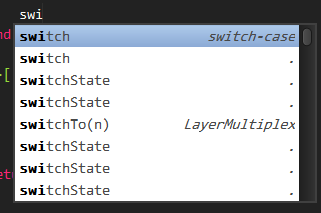刚开始使用lua的人肯定会不满lua居然没有switch这个语法。
但是熟悉lua的强大特性之后,你会发现其实switch是完全没有必要提供的^.^,因为lua有强大的table和function
例子:
- local key = 1
- local switch = {
- [1] = function()
- print("switch:"..1)
- end,
- [2] = function()
- print("switch:"..2)
- end,
- ["test"] = function()
- print("switch:test")
- end,
- }
-
- local fSwitch = switch[key] --switch func
-
- if fSwitch then --key exists
- local result = fSwitch() --do func
- else --key not found
-
- end
模版如下:
- local switch = {
- [case1] = function()
- --case 1
- end,
- [case2] = function()
- --case 2
- end,
- }
-
- local fSwitch = switch[key] --switch func
-
- if fSwitch then --key exists
- local result = fSwitch() --do func
- else --key not found
-
- end
为sublime增加switch自动补全 方法:
1、菜单-Preferences-Tools-New Snippet ,sublime自动新建一个文件
2、把代码全部复制进去,然后保存,文件名填 switch.sublime-snippet
-
-
- [${1:case1}] = function()
- ${2:--case 1}
- end,
- [${3:case2}] = function()
- ${4:--case 2}
- end,
- }
-
- local fSwitch = switch[${5:key}] --switch func
-
- if fSwitch then --key exists
- local result = fSwitch() --do func
- else --key not found
-
- end
- ]]>
- switch
- source.lua
- switch-case
-
方法二:
1、新建文本文档,把进去,然后保存,文件名写switch.sublime-snippet
2、sublime菜单-Preferences-Browse Packages打开文件夹
3、把刚才保存的switch.sublime-snippet文件放入User目录里面
这样就可以在sublime里面使用了
效果如下


from: http://blog.csdn.net/a82239946/article/details/42490405